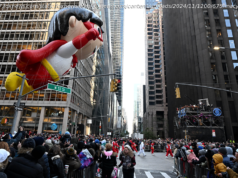Safety advocates have sought improvements and complained that too many agencies regulate the boats with varying safety requirements.
More than half of the 17 people killed when a tourist boat sank on a Branson lake were members of the same Indiana family, and they likely would not have been on the ill-fated trip but for a ticket mix-up.
Tracy Beck, of Kansas City, Missouri, said she recalled the family members waiting in line. After they stopped for a picture, she said, a ticket taker realized they should have boarded at a different location and reassigned them.
The grief-stricken community, known for its country shows and entertainment, hosted two vigils Friday night. About 300 people gathered in the parking lot of Ride the Ducks of Branson and others mourned at a church, singing “Amazing Grace” at both locations.
Later Friday, the Stone County Sheriff’s Department released a list of the people who were killed. In addition to the Indiana family, five people were from Missouri, two were from Arkansas and one was from Illinois.
The sheriff’s department identified the Indiana family members as 45-year-old Angela Coleman, 1-year-old Arya Coleman, 69-year-old Belinda Coleman, 76-year-old Ervin Coleman, 7-year-old Evan Coleman, 40-year-old Glenn Coleman, 70-year-old Horace Coleman, 2-year-old Maxwell Coleman, and 9-year-old Reece Coleman.
The people from Missouri were identified as 69-year-old William Asher, 68-year-old Rosemarie Hamann, 63-year-old Janice Bright, 65-year-old William Bright, and the crew member operating the boat, 73-year-old Bob Williams. Also killed were 64-year-old Leslie Dennison of Illinois, and 53-year-old Steve Smith and his son, 15-year-old Lance Smith, both from Arkansas.
The Rev. Zachary Klein, speaking at the gathering at the duck boat business, said he had no words of comfort to offer the families of victims “because there simply are no words to comfort them.”
Earlier, Mayor Karen Best said Branson is typically a city “full of smiles… But today we are grieving and crying.”
The accident at Table Rock Lake near Branson was deadliest accident of its kind in nearly two decades. State and federal investigators were trying to determine what went sent the vessel known as a duck boat to its demise. An initial assessment blamed thunderstorms and winds that approached hurricane strength, but it wasn’t clear why the amphibious vehicle even ventured out into the water.
The National Weather Service in Springfield, about 40 miles (64 kilometers) north of Branson, issued a severe thunderstorm watch for its immediate area Thursday, saying conditions were ripe for winds of 70 mph. It followed up at 6:32 p.m. with a severe thunderstorm warning for three counties that included Branson and the lake. The warning mentioned both locations. The boat went down about 40 minutes later, shortly after 7 p.m.
“When we issue a warning, it means take action,” meteorologist Kelsey Angle said.
A full investigation was underway, with help from the Coast Guard and the National Transportation Safety Board. Stone County Sheriff Doug Rader urged anyone with video or photos of the accident to contact authorities.
The agencies were briefing Missouri’s two senators on the accident. Democrat Claire McCaskill said she would look into possible “legislative solutions,” while Republican Roy Blunt called it a “tragedy that never should have happened.”
Suzanne Smagala with Ripley Entertainment, which owns Ride the Ducks in Branson, said the company was assisting authorities. She said this was the company’s only accident in more than 40 years of operation.
Twenty-nine passengers and two crew members were aboard for a pleasure cruise. Seven of the 14 survivors were hurt when the vessel went down. The captain survived, authorities said.
Among the injured was 14-year-old Loren Smith of Osceola, Arkansas. Her father, retired math teacher Steve Smith, and her brother died in the accident. Loren suffered a concussion.
“It’s a hard thing,” Steve Smith’s father, Carroll Smith, said of losing his only child and his only grandson. “It’s a very difficult day.”
Brayden Malaske, of Harrah, Oklahoma, boarded a replica 19th-century paddle-wheeler known as the Branson Belle on the same lake just before the storm hit.
At the time, he said, the water seemed calm, and no one was worried about the weather.
“But it suddenly got very dark,” he recalled.
In a short video taken by Malaske from the deck of the Belle, the duck boat can be seen wallowing through the choppy, wind-whipped lake, with water only inches from its windows. Dark, rolling waves crash over its front end. The footage ends before the boat capsizes.
Later, people on Malaske’s boat saw a duck boat passenger “hanging on for dear life” to the paddle wheel of the Belle, he said.
The mayor said Williams, known informally as “Captain Bob,” ”was a great ambassador for Branson.”
“He was at every event. He knew everyone. He was always promoting Branson,” Best said.
A survivor from the family who lost nine relatives said the captain told passengers not to bother grabbing life jackets.
Tia Coleman told Indianapolis television station WXIN that she and a nephew were the only survivors among 11 relatives aboard the boat. She said she lost all her children, but she did not say how many.
Coleman said the captain told passengers that they would not need life jackets. By the time of the accident, “it was too late.”
An email message seeking comment from Ripley Entertainment about Coleman’s comment was not immediately returned.
Named for their ability to travel on land and in water, duck boats have been involved in other serious accidents in the past, including the deaths of more than 40 people since 1999.
Five college students were killed in 2015 in Seattle when a duck boat collided with a bus. Thirteen people died in 1999 when a boat sank near Hot Springs, Arkansas.
“Duck boats are death traps,” said Andrew Duffy, an attorney whose Philadelphia law firm handled litigation related to two fatal duck boat accidents there. “They’re not fit for water or land because they are half car and half boat.”
Safety advocates have sought improvements and complained that too many agencies regulate the boats with varying safety requirements.
The boats were originally designed for the military, specifically to transport troops and supplies in World War II.






